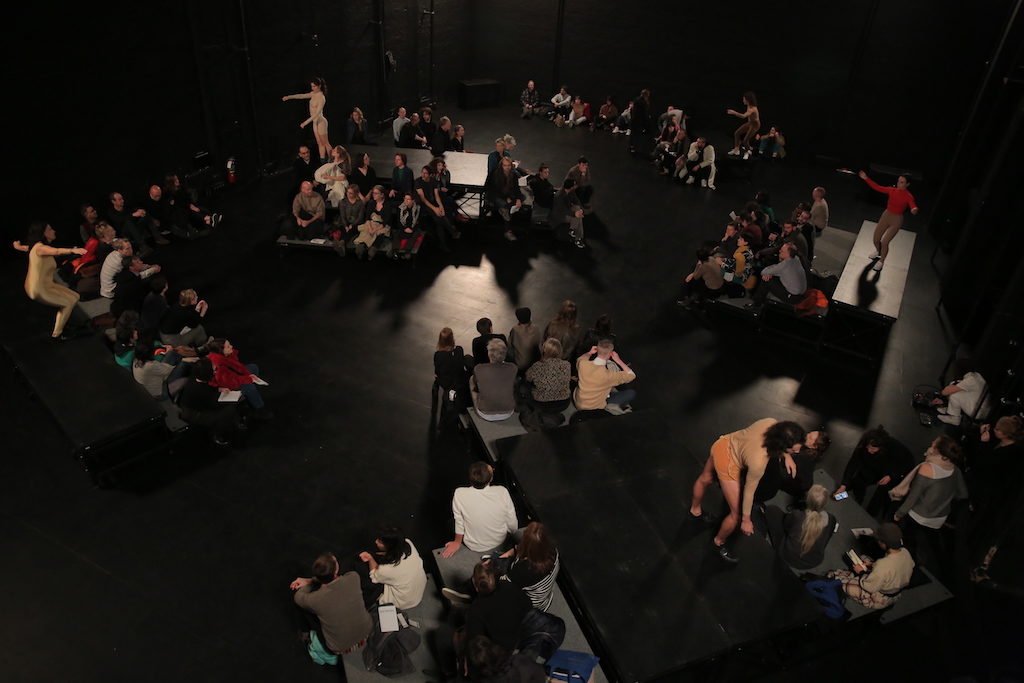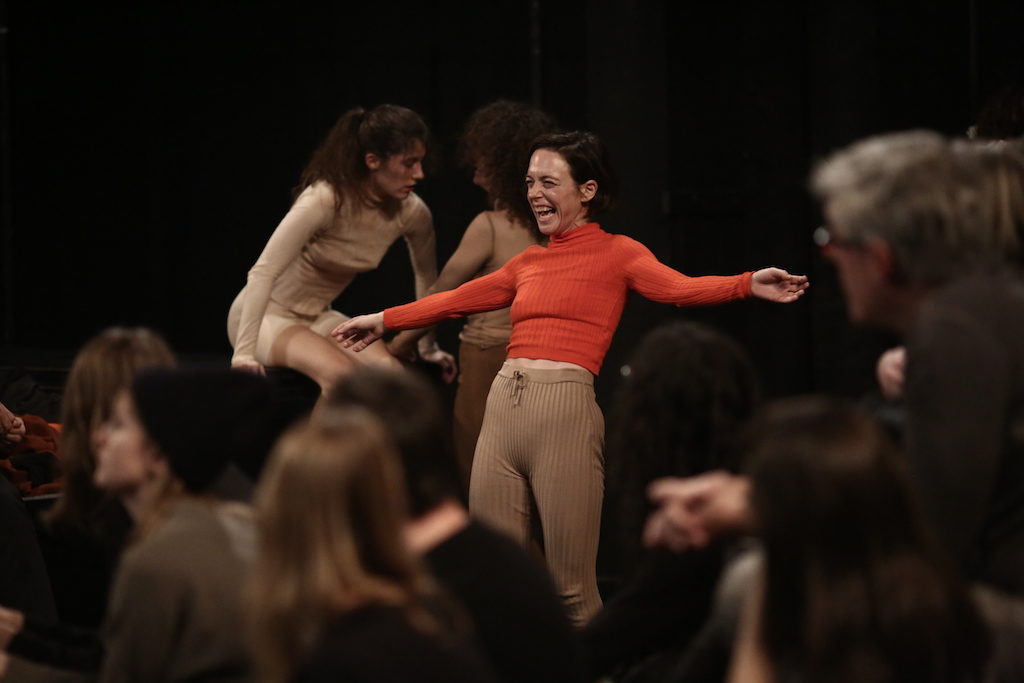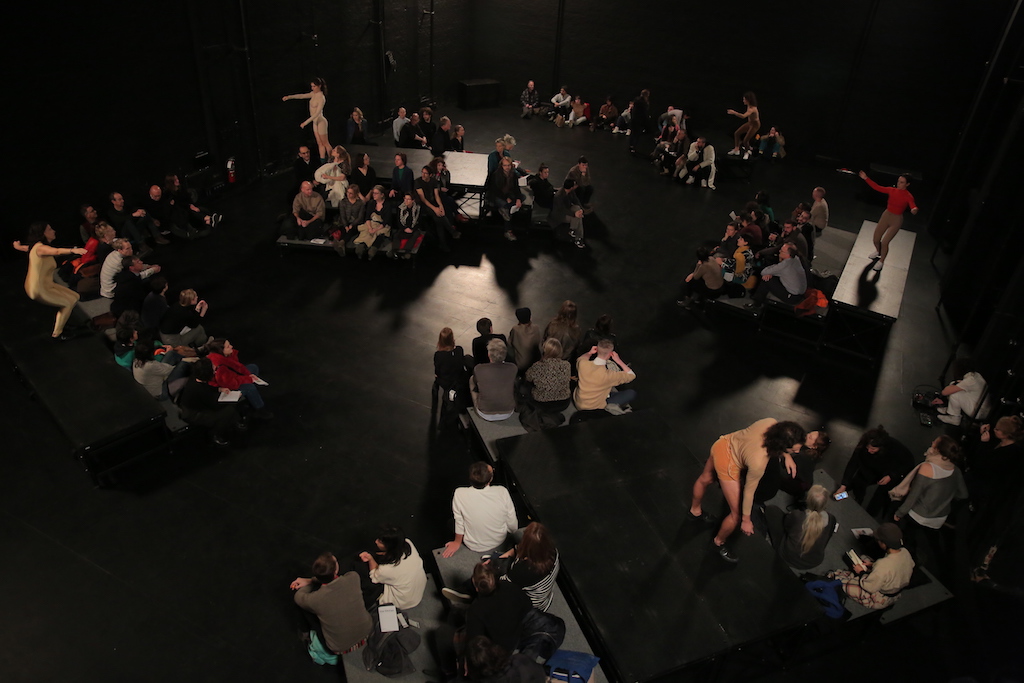[ad_1]

Ka Baird on live music, with dancers Moriah Evans, Lizzie Feidelson,Nicole Mannarino, João dos Santos Martins, and Lydia Okrent, performing in Moriah Evans, Configure, 2018, performance view.
PAULA COURT
The most lingering after-image from Moriah Evans’s Configure, which premiered last week at the Kitchen in New York, is that of her dancers’ shaking bodies, almost constantly quivering such that when they bent in place or pranced around, their cues from their choreographer seemed unstable. At first, the shaking was amusing, like watching a computer glitch being embodied in real life. After a bit, when repetition set in, the movement started to unsettle, in ways that recalled an exorcism or a seizure. By the performance’s end, more than an hour after the start, all the jittering seemed downright dangerous—a genuine threat to the dancers’ flesh and bones.
Evans managed to make all that come across as curiously graceful in a piece that seemed to engage the contrast between the interiors and exteriors of bodies—how inner organs impact motion and emotion. The 75-minute performance was built on oppositions like those between pain and pleasure, planned occasions and chance events, control and an utter lack of control. Evans’s choreographic concerns could lend themselves to bone-dry theorizing and self-seriousness, but, as in her past work, Configure was visceral and immediate. It was a work that viewers could feel in their veins, coursing around.
Sound helped in that regard. At the start of Configure, a whumping sub-bass swell rose up out of silence as five performers (Lizzie Feidelson, Nicole Mannarino, João dos Santos Martins, Lydia Okrent, and Evans herself—all of them excellent) began to shake. The sound rose more until it could be felt in the floor and the room started to feel as if it were moving along with the dancers, who had by then begun their gyrations in positions interspersed within the audience spread around the room. From the onset, the performance dared you to look away—to regard the jerky and grotesque motions of dancers moving mere feet away from your gaze with some degree of horror. But one can’t really turn away from Evans’s work, as engrossing as it tends to be.

Lizzie Feidelson, Nicole Mannarino, and Lydia Okrent performing in Configure.
PAULA COURT
Viewers were encouraged to become active participants, with word received upon entering that they were free to move around the room. The instructions were vague, but that may have been Evans’s intention. Her performances tend to come with directions, both for her viewers and for her dancers—specific instructions that, outwardly at least, often don’t make much sense. Evans seems to want to locate a state where bodies—in particular those belonging to women—refuse to perform functions that people in power demand of them.
That sense of defiance and unpredictability ran through the whole of Configure, which warbled between moments of extreme horror and strange beauty as the dancers moved and also alternated between odd spells of laughing and crying. At one point, Evans herself, wearing a shiny gold bodysuit designed by Strauss Bourque-LaFrance, collapsed at my feet, laughing hysterically, as though someone had just told her the funniest joke ever. Then her face dropped, and her communication morphed into what sounded like gasps of wrenching pain. Similarly erratic were the movements of Ka Baird, who supplied the performance’s jagged, aggressive sound. Baird would go from blowing into a recorder-like object with child-like energy to emitting blood-curdling screams, without any warning to signify the shift.
Ahead of Configure, viewers were handed print-outs of a 294-row spreadsheet that listed exercises and motions that would be enacted throughout the performance. The score ranged from the poetic—“container moves organ,” for example, was listed under the cryptic heading “ORGAN WORK”—to the profane, with designations for “pee a dance” and “shit a dance” (whatever those might mean). A few times during the dance, Evans and other performers lugged out a thick phonebook-like tome and scribbled down text while observing the other dancers. They were critiquing each other, noting when they could’ve done better during what the performance score termed the “Jump Festival”—a series of leaps into the air—and otherwise when their movements were acceptable.
As I took my own notes, I found my motions eerily similar. I got confused and wondered where instructions for such auto-criticality might be lurking within Evans’s score. But I’m not sure they would have mattered, anyway: Evans’s dancers seemed to be moving autonomously, each on their own, as though entirely independent of everything around them. They simply could not be controlled.
[ad_2]
Source link

